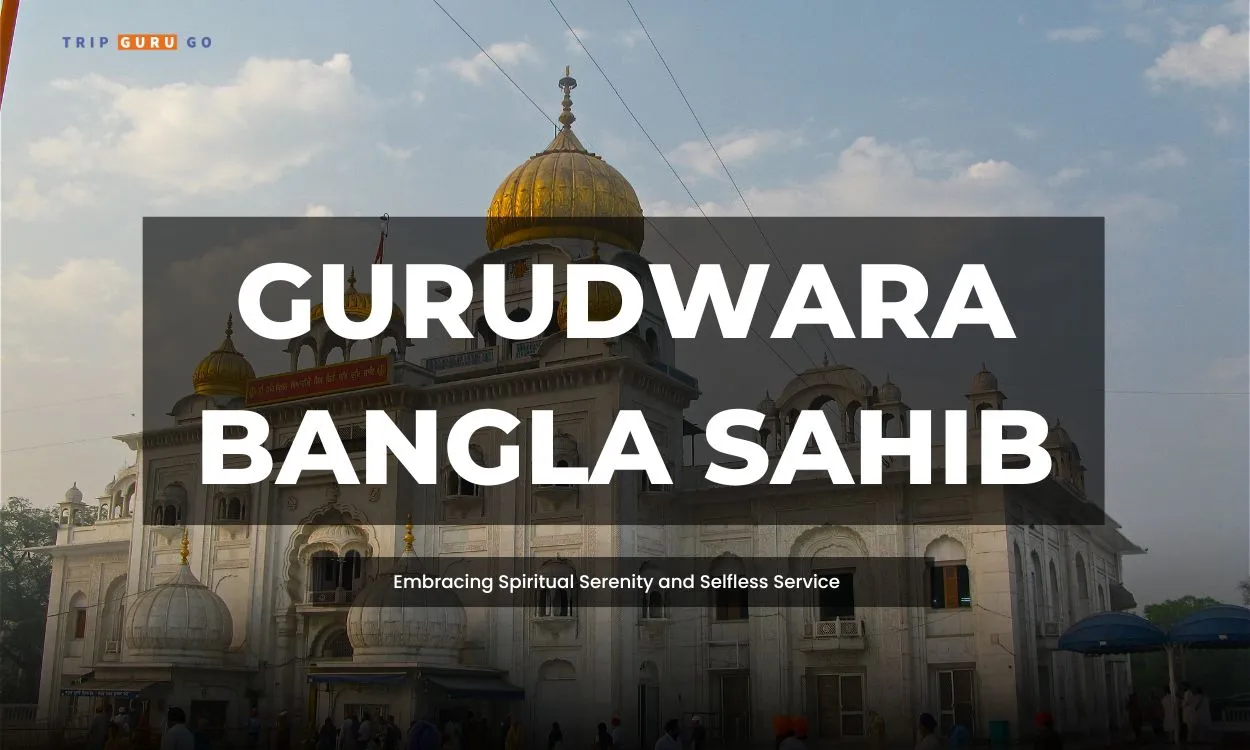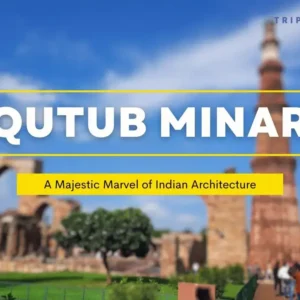Introduction:
Gurudwara Bangla Sahib in Delhi, a revered Sikh place of worship, holds a special place in hearts. Situated in the bustling city of Delhi, India, this sacred Gurudwara stands as a beacon of spirituality and compassion. A cherished destination for diverse backgrounds seeking solace and enlightenment, owing to its rich history and significance in Sikhism.
Gurudwara Bangla Sahib, one of the best places to visit in Delhi 2024, is revered for its promotion of equality, selfless service, and communal harmony. It warmly welcomes all, irrespective of faith, caste, or creed, thereby fostering universal brotherhood among its visitors.
In this article, we explore Bangla Sahib’s captivating history and enduring significance in Sikhism. Join us on a journey of discovery as we uncover the spiritual oasis that awaits within its hallowed walls.
History of Gurudwara Bangla Sahib
Gurudwara Bangla Sahib’s Origins and Name
Gurudwara Bangla Sahib’s origins date to the 17th century as Raja Jai Singh’s lavish home. The grand bungalow, “Bangla,” adorned Delhi, symbolized opulence and power during that era. Over time, this historic mansion underwent a profound transformation, becoming a spiritual haven for devotees of Sikhism.
Connection to Guru Harkrishan Sahib – The Eighth Sikh Guru
The pivotal moment in Gurudwara Bangla Sahib’s history came during the reign of Guru Harkrishan Sahib, the eighth Sikh Guru. A devastating smallpox epidemic that struck Delhi in 1664 claimed many lives and caused the populace great suffering. Guru Harkrishan Sahib, who was just a child at the time, fearlessly offered comfort and solace to the afflicted.
He selflessly served water from the Gurudwara’s sarovar, believed to possess healing properties, to the ailing populace. His compassionate acts not only provided physical relief but also strengthened the faith and devotion of the people.
Gurudwara Bangla Sahib’s Evolution
Throughout the centuries, Gurudwara Bangla Sahib has witnessed several historical events that have shaped its identity and significance. It has undergone numerous renovations and expansions to accommodate the growing number of devotees and visitors. The Gurudwara’s golden dome and majestic architecture showcase Sikhism’s legacy in Indian history.
Today, Bangla Sahib embodies Guru Harkrishan Sahib’s teachings and Sikhism’s profound philosophy. This Gurudwara, a beacon of hope, warmly welcomes everyone to experience its spiritual essence and partake in its selfless service.


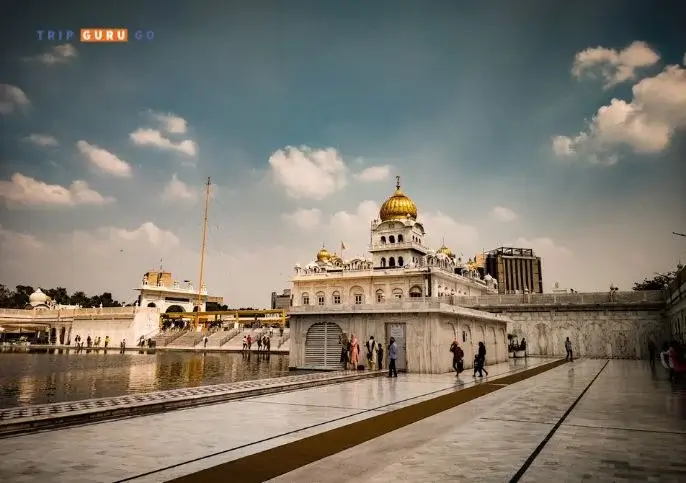
Gurudwara Bangla Sahib’s Architecture and Design.
Architectural Style of Gurudwara Bangla Sahib
Gurudwara Bangla Sahib boasts an exquisite architectural style that showcases a harmonious blend of Mughal and Sikh influences. The Gurudwara’s majestic façade showcases intricate carvings and graceful domes, blending Mughal opulence and Sikh simplicity.
The stunning white marble exterior exudes elegance and purity, complemented by the glistening golden dome that crowns the structure. This golden dome symbolizes the divine presence and serves as a guiding light for spiritual seekers.
The Gurudwara welcomes visitors with a sizable courtyard surrounding the sacred pond. It adds to the serene atmosphere of the location, encouraging reflection.
Significance of Sarovar at Bangla Sahib Gurudwara

Devotees revere the Sarovar at Bangla Sahib Gurudwara as a sacred body of water, holding deep spiritual significance. Historical accounts state the Sarovar was a small tank, or “baoli,” built by Raja Jai Singh. Later, it transformed into the serene pond we see today.
The Sarovar holds a profound connection to Guru Harkrishan Sahib, the eighth Sikh Guru. During the smallpox epidemic in Delhi, he selflessly served water from this very pond to heal the suffering masses. The history of Gurudwara Bangla Sahib etches compassion and service. The Sarovar symbolizes healing, purity, and divine grace.
Devotees and visitors perform “Sarovar Seva,” cleansing bodies and souls with a holy dip. The Sarovar’s tranquil ambiance encourages introspection and fosters a sense of spiritual rejuvenation.
Notable Features & Artwork in Bangla Sahib Gurudwara
Within Gurudwara Bangla Sahib, a feast for the eyes awaits, as intricate artwork and exquisite craftsmanship adorn the interiors. The walls and ceilings feature painted frescoes depicting Sikh history and Guru’s teachings.
The Langar Hall, a hallmark of Sikhism, is an integral part of the Gurudwara. It can accommodate a vast number of people, emphasizing the importance of community and equality in the Sikh faith. Here, devotees and visitors, regardless of backgrounds, eat together, fostering unity and oneness.
The Sikhs revere the Guru Granth Sahib, the holy scripture of Sikhism, within the Gurudwara. Adorned in rich fabrics and embellishments, the Guru Granth Sahib serves as a spiritual guide and the ultimate source of wisdom for all who seek its teachings.
Gurudwara Bangla Sahib’s architectural finesse, serene Sarovar, and splendid artwork create an awe-inspiring sanctuary. A place for divine ambiance, solace, and profound Sikh teachings for devotees and seekers.
Spiritual Significance of Bangla Sahib Gurudwara
Religious Practices and Rituals at Bangla Sahib:
- “Prabhat Pheris”: early morning processions with hymn recitations
- Engaging in “Ardaas” (prayer): expressing heartfelt supplications and gratitude
- Traditional musical instruments and soul-stirring “Kirtan” (hymn singing)
Importance of “Ardaas” and “Kirtan”:
- Ardaas” serves as a powerful and reverential prayer.
- “Kirtan” elevates the atmosphere with devotion and a sense of oneness with the divine.
Role of Guru Granth Sahib in Daily Activities:
- Devotees accord utmost reverence to Guru Granth Sahib and place it on a beautiful throne.
- “Paath” (continuous reading) of Guru Granth Sahib ensures a continuous connection with its divine wisdom.
- Devotees seek solace, guidance, and blessings from the holy scripture.
Gurudwara Bangla Sahib in Delhi holds immense spiritual significance for devoutly observing Sikh practices, connecting with the divine, and upholding Sikh values. It stands as a beacon of love, compassion, and selfless service, providing solace and spiritual enlightenment to all who visit. This revered Gurudwara is among the famous religious places in Delhi, attracting visitors from all walks of life seeking spiritual nourishment and a sense of unity in the spirit of Sikhism.
Langar Experience at Gurudwara Bangla Sahib
Langar in Sikhism: Introduction at Gurudwara Bangla Sahib
- “Langar” is a central tenet of Sikhism, representing the act of serving free meals to all, regardless of social status, as an expression of equality and selfless service.
- The practice of “Langar” embodies the spirit of communal sharing and fosters a sense of unity among all who partake in the meal.
Organizing Langar at Gurudwara
- The Langar Hall at Gurudwara Bangla Sahib serves meals to thousands of visitors daily, creating a bustling and vibrant atmosphere.
- A dedicated team of volunteers, known as “Sevadars,” manages the Langar operations efficiently and with utmost devotion.
- The Langar menu typically includes simple yet nutritious vegetarian dishes prepared with love and care, ensuring that all visitors are well-fed and satisfied.
Community Involvement and Volunteer Opportunities:
- This Gurudwara encourages community participation in Langar seva (service).
- Devotees and visitors are welcome to volunteer for various tasks, such as food preparation, serving, and cleaning.
- Sikhs regard the act of selfless service, or “sewa,” as a noble deed and an integral part of their values.
The Langar at Bangla Sahib embodies unity, compassion, and sharing in Sikhism. Volunteers’ efforts and community involvement showcase “Langar’s” significance in fostering inclusivity and care.
Langar Timings at Gurudwara Bangla Sahib
Langar Serving Timings
Gurudwara Bangla Sahib’s Langar Hall operates throughout the day, offering meals to visitors at specific times.
- Morning: The Langar service begins early in the morning, around 4:00 or 5:00 AM, to serve breakfast to devotees attending the morning prayers.
- Afternoon: The Langar Hall remains open for lunch from around 12:00 PM to 3:00 PM, catering to a significant number of visitors.
- Evening: They serve dinner in the evening, starting from approximately 7:00 PM and continuing until 9:00 PM.
Extended Langar Hours during Special Occasions & Festivals
Gurudwara Bangla Sahib experiences an increased influx of visitors during special occasions and festivals.
- Gurpurab Celebrations: During Sikh Gurus’ birth anniversaries like Guru Nanak Dev Ji’s Gurpurab, Langar Hall serves meals 24/7.
- Baisakhi: During Baisakhi, the Langar service extends hours to accommodate the celebratory crowd of visitors.
- Other Festivals: During festivals like Diwali and Holi, the Langar Hall extends its hours to serve devotees and well-wishers.
Gurudwara Bangla Sahib’s Langar service exemplifies the spirit of selfless service and inclusivity, offering nutritious meals throughout the day. Extended Langar hours during special occasions create a warm, memorable experience for all visitors.
Visiting Gurudwara Bangla Sahib
Gurudwara Bangla Sahib Address & Location
- Gurudwara Bangla Sahib is located at Ashoka Road, Connaught Place, New Delhi, India.
- Its central location in the heart of Delhi makes it easily accessible from various parts of the city.
Respectful Attire and Conduct Tips
- Dress Modestly: When visiting Bangla Sahib Gurudwara, it is respectful to dress modestly, covering your head with a scarf or a handkerchief. Avoid wearing revealing or inappropriate attire.
- Remove Shoes: Before entering the Gurudwara premises, visitors have to remove their shoes and leave them at the designated shoe counter.
- Maintain Silence and Reverence: Inside the Gurudwara, maintain peace and solemnity by refraining from loud conversations and being mindful of the atmosphere.
- Photography and Videography: Visitors can take photos in outer areas, but refrain from doing so inside the main prayer hall to show respect.
Parking and Accessibility at Gurudwara Bangla Sahib
- Gurudwara Bangla Sahib provides ample parking space for the convenience of visitors arriving by private vehicles.
- For those using public transportation, the Gurudwara is easily accessible via the Delhi Metro, with the Patel Chowk Metro Station being the closest.
- Auto-rickshaws and taxis are readily available in the vicinity, offering a convenient mode of transportation to the Gurudwara.
When visiting Gurudwara, following these guidelines ensures a respectful and meaningful experience. The Gurudwara’s serene ambiance and spiritual sanctity create an environment conducive to introspection and connection with the divine.
Events at Gurudwara Bangla Sahib
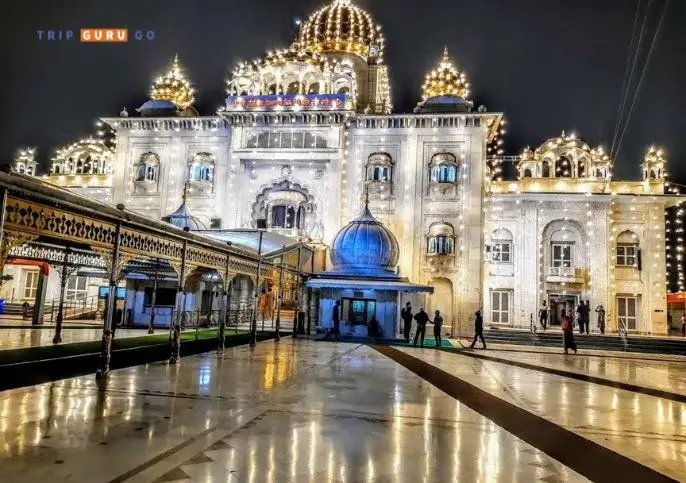
Gurudwara Bangla Sahib hosts vibrant events, including Guru Nanak Jayanti, with colorful decor and special prayers. It is a joyous occasion where devotees participate in soul-stirring hymn recitations and express their spiritual devotion.
- Baisakhi: Baisakhi in April celebrates the harvest festival and formation of the Khalsa, the Sikh warrior-saint order. Gurudwara is adorned vibrantly; visitors join prayers and Langar, spreading festival joy and essence.
- Diwali: At Bangla Sahib, devotees celebrate the festival of lights, Diwali, with enthusiasm. They illuminate the Gurudwara with earthen lamps and candles, creating a mesmerizing ambiance. The celebrations include special Kirtan sessions, and devotees actively participate with heartfelt devotion and reverence.
Gurdwara’s program fosters unity, love, compassion, and a militant spirit in its deep teachings.
The Community Kitchen
At Gurudwara Bangla Sahib, the community kitchen, lovingly called the “Langar Hall,” is the heart of selfless service and unity. Every day, devoted volunteers, known as “Sevadars,” work with passion and dedication to prepare and serve thousands of wholesome meals. With fresh ingredients and a harmonious effort, they create a soulful Langar experience for all.
The Langar Hall’s spirit of equality and compassion reflects Sikh values, bringing people from diverse backgrounds together in the joy of communal sharing. The beautiful principle of “sewa” unites hearts, fostering togetherness among all in this sacred meal.
Donations and Sewa
Generous donations maintain Gurudwara Bangla Sahib’s operations, supporting free meals and community initiatives. Visitors can participate through volunteering, donating supplies, or offering financial contributions. Acts of kindness create a culture of compassion, making the Gurudwara a symbol of love and service.
Festive Decorations and Illuminations
During special occasions and festivals, Gurudwara Bangla Sahib comes alive with enchanting adornments and mesmerizing lighting decorations.
How the Gurudwara is Adorned During Special Occasions and Festivals
- Gurudwara Bangla Sahib is transformed into a spectacle of joy during special occasions and festivals.
- Elaborate decorations, including vibrant flowers, elegant drapes, and intricate designs, grace the Gurudwara’s premises, enhancing the festive spirit.
- The lavish festive decor welcomes devotees and guests, amplifying the divine atmosphere.
The Mesmerizing Lighting Decorations During Gurpurab Celebrations:
- Gurpurab celebrations, especially Guru Nanak Jayanti, witness a breathtaking display of lighting decorations at Gurudwara Bangla Sahib.
- The entire Gurudwara complex dazzles with a symphony of colorful lights, creating an awe-inspiring spectacle.
- The illuminations add to the reverent fervor, symbolizing the triumph of light over darkness and spreading the message of hope and joy.
The festive decorations and mesmerizing lighting at Bangla Sahib Gurudwara infuse the atmosphere with divine splendor and create a welcoming ambiance for all. During Gurpurab and special occasions, the Gurudwara exudes joy, inviting all to immerse in the spiritual essence.
Historical Artifacts and Exhibits
Bangla Sahib Gurudwara takes pride in the preservation and display of historical Sikh artifacts, providing a glimpse into the rich heritage of Sikhism.
Preservation and Display of Historical Sikh Artifacts:
- The Gurudwara houses a collection of precious historical artifacts that hold immense significance in Sikh history and culture.
- Gurudwara Bangla Sahib carefully preserves ancient scriptures, manuscripts, paintings, and relics of Sikh Gurus.
- Dedicated exhibition spaces within the Gurudwara showcase these artifacts, allowing visitors to connect with the glorious past of Sikhism.
The Museum and its Significance in Educating Visitors about Sikh History:
- The museum at Gurudwara serves as an educational hub, providing valuable insights into the history, philosophy, and traditions of Sikhism.
- Through exhibits, interactive displays, and informative panels, the museum offers a comprehensive understanding of Sikh heritage and the teachings of the Gurus.
- Visitors, regardless of their faith or background, have the opportunity to enrich their knowledge about Sikh history and culture, fostering a sense of cultural appreciation and understanding.
Gurudwara Bangla Sahib’s historical artifacts and exhibits offer a profound Sikh legacy experience. The museum promotes cultural awareness and spiritual growth, inspiring visitors with timeless wisdom and values.
Guru Ka Bagh
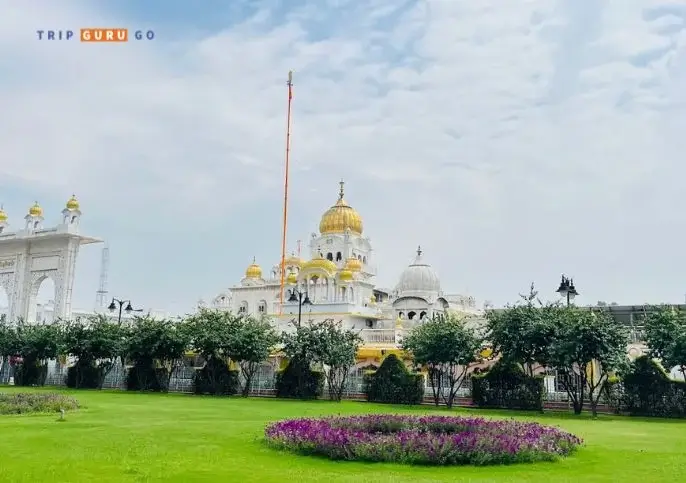
Guru Ka Bagh is a serene and beautifully landscaped garden area within the Gurudwara Bangla Sahib complex. With its lush greenery and historical significance dating back to Guru Harkrishan Sahib’s visit, the garden provides a peaceful retreat for visitors. It offers a space for reflection and spiritual contemplation amidst the bustling city, complementing the Gurudwara’s essence of peace and harmony.
Nishan Sahib and its Significance
Nishan Sahib, the Sikh religious flag, proudly flies atop the main dome of Gurudwara Bangla Sahib. It symbolizes the unity and sovereignty of the Sikh community, serving as an emblem of righteousness, equality, and courage in Sikhism. The presence of Nishan Sahib at the Gurudwara symbolizes its sanctity as a Sikh place of worship and communal gathering.
Learning Opportunities
Gurudwara Bangla Sahib offers learning opportunities through “Gurmat Samagam,” spiritual congregations where teachings, kirtan, and discourses take place. These gatherings enable visitors to deepen their understanding of Sikh philosophy and principles. Additionally, the “Gurmukhi Pathshala” welcomes individuals of all backgrounds, providing a learning platform for the Punjabi script and Sikh scriptures, and fostering an inclusive environment for cultural and spiritual enrichment.
Langar Hall Etiquette
The Langar Hall at Gurudwara Bangla Sahib operates on the principles of equality and communal sharing. Gurudwara encourages visitors to maintain cleanliness, discipline, and respect while partaking in the Langar. Observing silence and showing gratitude for the meal is a way of paying respect to the Sikh tradition of Langar. Following these etiquettes ensures that the experience in Guru Ka Bagh, witnessing the Nishan Sahib, attending spiritual gatherings, and partaking in the Langar becomes a meaningful and spiritually enriching journey at Bangla Sahib.
Cultural Exchange and Hospitality
At Gurudwara Bangla Sahib, the spirit of hospitality extends to people of all faiths. The Gurudwara warmly welcomes visitors from diverse backgrounds, fostering a culture of inclusivity and cultural exchange. Many visitors share heartwarming stories of their experiences at the Gurudwara, where they have felt embraced and uplifted by the sense of community and love. The Gurudwara’s open doors symbolize its commitment to promoting harmony and understanding among people of different beliefs.
Gurudwara Bangla Sahib’s Outreach Programs
Beyond its spiritual services, Gurudwara Bangla Sahib actively engages in social and charitable initiatives. The Gurudwara takes on a significant role in contributing to the welfare of the local community and beyond. Through various outreach programs, it addresses the needs of the underprivileged and extends support in times of crisis. The selfless service of volunteers and the Gurudwara’s commitment to making a positive impact exemplifies the essence of Sikhism’s principles.
How to Reach Bangla Sahib Gurudwara?
To reach Gurudwara Bangla Sahib in New Delhi, India, you can follow these steps:
- Nearest Metro Station: The nearest metro station to Gurudwara Bangla Sahib is “Rajiv Chowk” (also known as Connaught Place). It is located on the Yellow Line and Blue Line of the Delhi Metro.
- By Metro: To reach Gurudwara Bangla Sahib, take the metro to the “Rajiv Chowk” station. From there, it’s a short 10-15 minute walk or a quick auto-rickshaw ride.
- By Cab/Taxi: Book a cab or use a ride-hailing app to reach “Bangla Sahib, Connaught Place.” It’s a well-known destination that drivers will recognize.
- By Bus: Delhi has an extensive bus network, and there are several bus stops near Connaught Place. Look for buses that pass through “Connaught Place” or “Janpath” and get off at the appropriate stop. From there, you can walk to the Gurudwara.
- Google Maps: Use Google Maps to find “Gurudwara Bangla Sahib” and get route options by metro, bus, or walking.
Remember, Respect Gurudwara sanctity: Dress modestly, cover your head, and be respectful during your visit.
Nearby Attractions of Bangla Sahib:
- Rashtrapati Bhavan: The official residence of the President of India, known for its stunning architecture and extensive gardens.
- India Gate: A prominent war memorial honoring soldiers who sacrificed their lives during World War I, with a vibrant ambiance for evening strolls.
- Connaught Place: A bustling commercial hub offering shopping, dining, and entertainment experiences in the heart of Delhi.
- National Museum: A treasure trove of Indian art, history, and culture, showcasing a diverse collection of artifacts and exhibits.
- Jantar Mantar: An ancient astronomical observatory featuring remarkable instruments for celestial observations.
- Agrasen ki Baoli: A historical stepwell with intricate architecture, often associated with intriguing legends.
- Gurudwara Sis Ganj Sahib: Another significant Sikh shrine, honoring Guru Tegh Bahadur’s sacrifice, is located nearby.
- Bangla Sahib Park: A serene park adjacent to the Gurudwara, offering a peaceful retreat amidst greenery and water features.
Visitors can explore nearby attractions, immersing in Delhi’s rich cultural and historical heritage from Gurudwara Bangla Sahib.
Conclusion
Gurudwara Bangla Sahib stands as a beacon of spiritual and cultural richness, embodying the values of Sikhism. Its history is intertwined with the legacy of Sikh Gurus and their profound teachings. A visit to this sacred abode offers a profound experience of devotion, reflection, and unity. Visitors witness the Sikh faith’s essence: selfless service, compassion, and love in Gurudwara’s ambiance. Bangla Sahib inspires inclusivity and humanity, fostering oneness for a better world.
FAQs
Bangla Sahib Gurudwara is historically significant, commemorating Guru Har Krishan Sahib Ji’s visit, and known for its sacred Sarovar and compassionate Langar, providing free meals to all visitors.
Gurudwara is open 24/7, welcoming visitors at any time of the day or night to pay their respects and seek blessings.
Yes, visitors are required to follow a modest dress code. Men and women should cover their heads with a scarf or handkerchief and wear clothes that cover their shoulders and legs.
No, there is no entry fee. Bangla Sahib Gurudwara is open to all visitors without any charge. However, donations are welcomed to support the Langar and charitable activities.
Yes, Gurudwara Bangla Sahib provides accommodation in their Sarai (guest house) for pilgrims and visitors. Availability is on a first-come, first-served basis.
Gurudwara Bangla Sahib is renowned for its religious significance, commemorating Guru Har Krishan Sahib Ji’s visit, and offering a sacred Sarovar and Langar with free meals for all.
Gurudwara remains open every day of the week. There is no specific closing day, allowing devotees and visitors to visit at any time.
Yes, langar is served daily at Bangla Sahib Gurudwara. This community kitchen provides free meals to all, promoting equality and selfless service.

